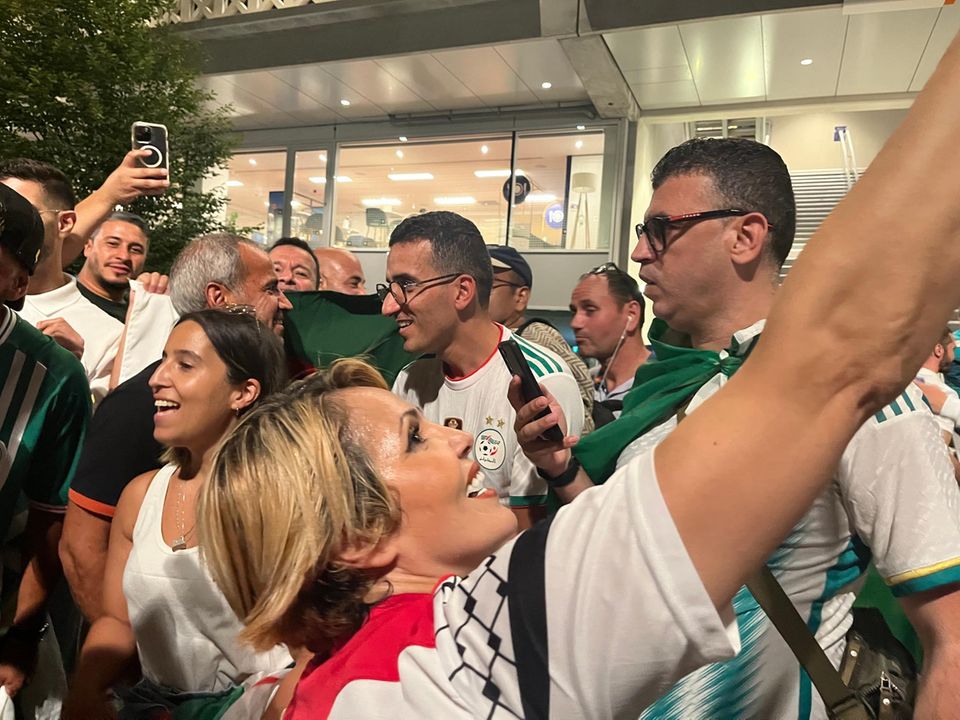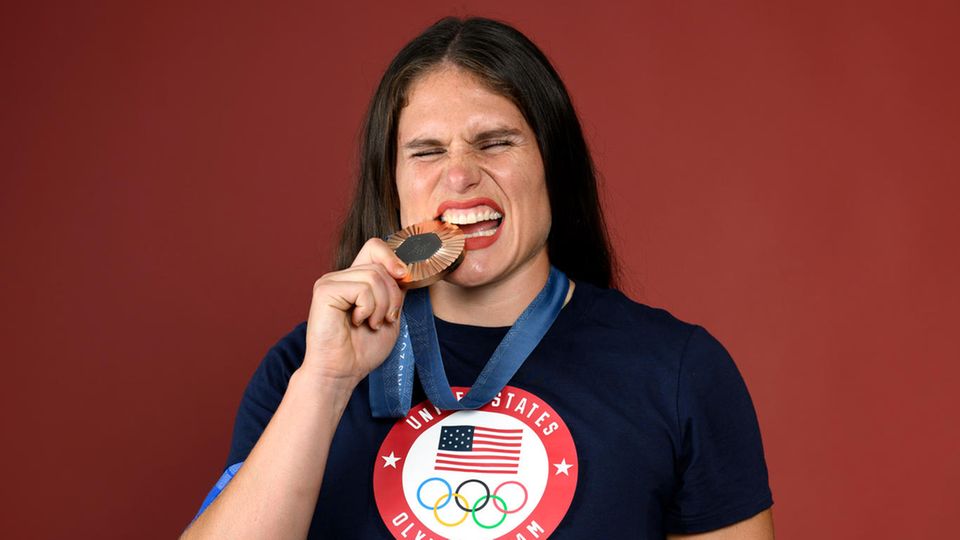The Algerian boxer Imane Khelif is being attacked online – for her fans she is already the greatest. Especially for the women. The story of a fighter.
Nadia has tied her white headscarf at the back of her neck and an Algerian flag is draped over her shoulders. She came to the Roland Garros stadium late on Tuesday evening with her sister and a friend. “I’ve never seen women’s boxing live,” says the Parisian. “But today Imane Khelif is competing for all Algerians. Although – no, what nonsense. I mean, of course: for all Algerian women!”
The stadium is not sold out, but around an hour before the start of the competition the stands are already well filled, hundreds of green and white flags with a red star and crescent hang over the dividing bars. Outside you can hear trilling cheers, megaphones, drums. Everyone is filming with their cell phones, Algerian television is also there: Imane Khelif is being celebrated like a star. The fact that other fights are taking place that evening, including the semi-finals in the men’s light middleweight division, is irrelevant.
She was not a “real” woman, it was said after her first victory
“I’m a housewife, I know nothing about sport,” admits Assia from the Paris suburb of Bondy. “I’m here today because I want to support Imane. We all want that!” For a week, the 25-year-old Algerian boxer Imane Khelif has had to endure a fight that takes place outside the ring and has long since undermined all principles of fairness: she is not a “real” woman, it was said after her 46-second victory against the Italian Angela Carini. The International Olympic Committee (IOC) made a serious mistake, Khelif is not allowed to take part in women’s boxing at all.
These accusations are being pushed by the “International Boxing Association” (IBA). This controversial and Russian-dominated association claims that a gender test last year showed that Khelif had XY chromosomes. It was later said that the Algerian’s testosterone levels were elevated. Last Monday, those responsible wanted to present “evidence” of both – or something else, no one knows for sure.
Now it’s not as if Imane Khelif started boxing just yesterday. She has been taking part in international competitions since 2018 – she was already muscular at that time, but no one had ever been particularly interested in her gender. That changed when she defeated a previously undefeated Russian young talent at the Boxing World Championships in India last year. Three days later, the Algerian was disqualified because she had violated the competition criteria. The Taiwanese Lin Yu-ting was also excluded from the World Championships because of this. Both athletes are allowed to compete in Paris. The IBA association has lost recognition from the IOC due to various scandals. The decisive factor for participation in the Olympic Games is whether the participants are female according to their passport and have previously only boxed as women.
Testosterone levels have increased, especially on the Internet
If an increased testosterone level has been noticeable in recent days, then it has been primarily on the Internet: The social media platform “X” has blossomed into a veritable expert forum for the “Y” chromosome. One of the meanest tweets was sent by Harry Potter author JK Rowling: In Imane Khelif’s face you can see the “grin of a man” who is protected by a “misogynistic” establishment. This put Imane Khelif, who was born and raised as a girl, at the center of a transphobic witch hunt.
Of course, you can’t ignore the category of “gender” in competitive sports. But unfortunately biology is apparently confusing. One of its rules is that every man has a Y chromosome. But not every woman automatically becomes a man because of a Y chromosome. In men, on the other hand, the chromosome can disappear over the course of life through cell division. If a woman with a “Y” is a man according to “X”, then what is an older gentleman without a “Y”?
She is one of the biggest social media stars at the Games – and has a moving message
01:16mins
The history of women’s sport shows that testing is not that easy
Rowling’s like-minded women now claim that a simple test is enough to clarify all gender issues. That sounds good at first. But a look at the history of women’s sport shows that it is not that simple. The Spanish hurdler Maria José Martínez-Patiño, born in 1961, had already won numerous competitions when she was suddenly told at the age of 24 that she was a man. Two years earlier, another of the tests that were still mandatory at the time had said the opposite.
A few years later, the ruling was revised and Martínez-Patiño was again considered a woman. Many such examples can be found from different decades. This is one of the reasons why the IOC has not carried out gender tests since 1999. Nature simply offers more variants than an understanding of “woman” and “man” that is fixated on clarity and appearance would like. In the case of Imane Kehlif, however, there may be something else.
“If Imane were a stocky Finnish woman and had long blonde hair instead of short black hair, I’m sure we wouldn’t hear so much shouting.” The woman who says this is called Halima and introduces herself as a “Muslim lesbian and football player.” “But of course, we Arabs like to cheat, everyone knows that,” she says with a grin. “But let’s be honest: if a bunch of brothers down there in the boxing ring wanted to cheat a guy into women’s sports, they would have dressed him up more. Imane doesn’t even wear lipstick. Just earrings sometimes.”
In the Algerian-French community, the boxer who was vilified has become a heroine over the past week. And a role model. Almost everyone now knows her story, as she told it on the television channel “Canal Algérie,” for example.
Imane Khelif is the pride of the nation. And a symbolic figure
Imane Khelif grew up in Biban Mesbah, a village in the northern Algerian province of Tiaret. She always loved playing football, says Khelif. When the boys tried to intimidate her because of it, she fought back, quickly and undaunted. A teacher finally encouraged her to start boxing. How difficult that must have been becomes clear in one sentence: “I come from a conservative family in a conservative region,” Imane Khelif told the television reporter almost shyly. “Boxing was considered a sport reserved for men there.” She earned the money for the trips to training in the city by recycling and selling homemade bread. After three years of training, she competed in the World Championship for the first time in 2018 at the age of 19. She boxed her way into a career that seemed anything but predetermined.
Imane Khelif now enjoys more than just her father’s recognition. Algerian politicians, high-ranking sports officials and feminists support the athlete in rare unity. For some, she is the pride of the nation. For others, she is a fighter who frees femininity from traditional gender roles. And women’s boxing is suddenly on everyone’s lips.

At around 10:40 p.m. on this evening of the competition, the athletes enter the ring. “Imane! Imane!” echoes from the stands. The Thai Janjaem Suwannapheng wants to use her speed to counteract Khelif’s punching power, but the Algerian is accurate and eight centimeters taller. From the first second, she dominates the fight, effortlessly keeping her opponent at a distance. In the end, she wins convincingly by five points to zero. Final.
Her fans continued to celebrate on the streets around the stadium long after her victory. Women, girls – and yes, men too, not all of whom act as if they have long been champions of feminism. But that can still change. Next Friday, Imane Khelif will fight for the gold medal.
Source: Stern
I am Pierce Boyd, a driven and ambitious professional working in the news industry. I have been writing for 24 Hours Worlds for over five years, specializing in sports section coverage. During my tenure at the publication, I have built an impressive portfolio of articles that has earned me a reputation as an experienced journalist and content creator.




